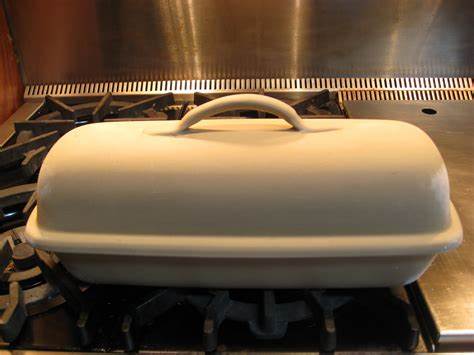November 25, 2021 - 9:37am

COLD OVEN START

Up until now I have been putting my risen loaf (in an oblong, unglazed, clay baker) directly into a hot oven .. aprox 425 f. However, someone pointed out that I was in danger of having the room temp clay baker crack when put in a hot oven. I'm not terribly comfortable putting my risen dough in a preheated clay baker. I know it works for some people who have experience at that.
This got me thinking that perhaps putting the risen, fully proofed, dough (in a clay baker) into a COLD OVEN and letting it bake to completion might be a good way to go.
Does anyone have any thoughts on this method ?


If you do a search (top right) for "cold oven" you get lots of hits:
https://www.thefreshloaf.com/search/node/%22cold%20oven%22
Thank you, Happy Cat.
Certainly a lot of great information on that link you so kindly provided.
I tried it today. The bake time was much longer, of course, 1 full hour, but I was thrilled with the results. Especially enjoyed the thin "cracky" crust.
This method works but not the way you described it, i.e. not with the fully proven dough. As you place your cold clay baker in a cold oven and it begins to warm up, the proofing inside will continue for a while before it begins to bake and by then the loaf will overproof and collapse.
So do not proof the dough fully and then this method will work very well.
A variation of that method is to place your cold clay baker into a preheated oven but not directly on the oven rack. Place your clay baker on a small baking tray or baking sheet, even a few layers of thick aluminum foil between the clay and the hot oven rack will do. This will form a barrier and will eliminate thermal shock in a place where hot metal touches cold clay.
There is a blog entry at King Arthur Baking comparing the cold start method with the pre-heated Dutch oven method:
https://www.kingarthurbaking.com/blog/2017/07/05/baking-in-a-cold-dutch-oven
Breadtopia's instructions for starting out cold do recommend oiling the baker first, noting that the hot baker will have less sticking problems and will provide more oven spring.
https://breadtopia.com/wp-content/uploads/2017/03/OblongClocheCareFullPage.pdf
Probably the most important thing to remember, as mariana points out, is to not let your dough fully proof before putting it in the cold oven.
Dave
the KAF link clearly shows (supported by my personal experience) that there is no difference between putting the dough in a preheated or cold dutch oven. I have done this with both cast iron and clay.
I would strongly recommend parchment paper, since you are more likely to stick to the pot when starting cold.
As indicated in the KAF piece, the size of your pot, relative to the dough, is your main driver of success.
I also have an oblong clay baker that I like to use for 'toast loaves'. However, when I went to make my first loaf using this baker (several years ago) I decided to follow the instructions from Breadtopia and use oil since the bottom of the baker was not glazed--big mistake! The loaf stuck all over the bottom and sides and would not come out without being torn. So, painful lesson learned and I was quickly back to strictly using parchment from then on, without any issues whatsoever.
You indicate you are reluctant to put your dough in a pre-heated baker, which I understand. But, if you use a large enough piece of good quality parchment (the thin stuff does not work so great for heavy loaves) to turn your dough out onto, it is pretty straight forward as far as lifting the parchment and dough and carefully lowering it into the bottom of the baker. The low sides of the oblong bakers make this pretty safe and I actually have batard size bakers that I use upside down, so I'm only lifting the dough into the flat lid rather than trying to lower it down into the deep bottom piece. You can fold the overhanging paper down over the edge with oven mitts to keep it out of the way of the dough. Just take the same precautions as you would with the sides of a hot oven or grill. I never have to put any pans or anything else under the bakers to deflect heat and the parchment protects the bottom of the loaves from burning, at least in my experience.
All that being said, it sounds like you are exploring the cold oven start method, which many people use with great success as well. Let us know how it goes! My curiosity has now been piqued regarding the cold start method!
I would not recommend putting clay bakers into a hot oven.
I have both the bell shaped and oblong clay bakers. I have had them and used them very successfully for many years without any problems.
I do prefer my bell shaped clay baker over the oblong because I bake large loaves. Apx. 2 lbs. each.
I bake two large loaves at once in my oven. It fits perfect with my oblong heavy iron enameled covered roaster into my large oven.
I have always preheated them both starting in a cold oven. Then slide my proofed loaves that have been turned onto a parchment lined wooden pizza paddle into the pre heated bakers. I get beautiful oven spring loaves of sourdough bread.
Cut your parchment to the shape of the baker. I use heavy heatproof gloves for protection from hot lids. I place the hot lids either on the opened oven door and/or the heat protected area counter behind me. I'm old and if I do this anyone can. It helps to practice your approach with cold everything.
Happy Holidays,
Sylvia